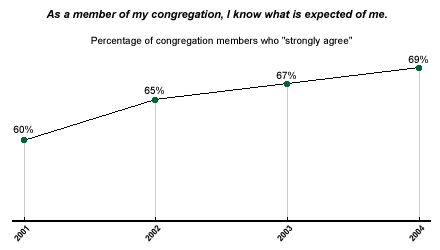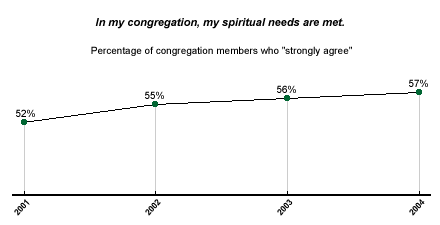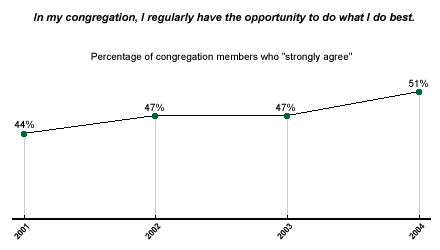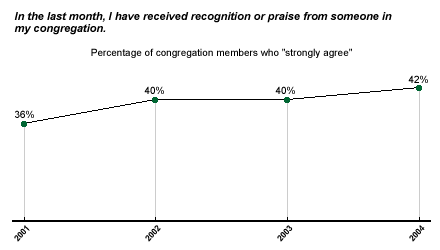Results from Gallup's latest national Congregational Engagement Index survey* suggest American congregation members are more likely to be engaged with their own religious congregations -- that is, involved and emotionally attached to their faith communities -- than they have been since the Index's inception in 2001. Of the 12 items that Gallup uses to measure congregational engagement, seven have increased significantly this year. This week, we'll discuss the first four and discuss the others next week.
1. "As a member of my congregation, I know what is expected of me."
Clear expectations are a key element in creating engaged congregation members. If they are to feel as if they truly belong, individuals need to know what is expected of them as members. They need to know the "rules of the game" -- otherwise they tend to make up their own. And there is a flipside to communicating expectations: Members also need to know what to expect from their leaders. In 2001, 60% of members of faith communities "strongly agreed" that they knew what was expected of them (giving the item a score of "5" on a scale of 1 to 5); that percentage grew to 69% in 2004.

2. "In my congregation, my spiritual needs are met."
The primary reason most people seek to belong to a congregation is to address their spiritual needs. Such needs differ from person to person -- some want inspiring worship services, some seek out the bonds formed in a support group or Bible study, others derive the most fulfillment from helping to serve meals in a soup kitchen with fellow members. Whatever their specific need, if members feel their congregations aren't addressing them, they will look elsewhere or simply grow increasingly less engaged.
In 2001, slightly more than half (52%) of members "strongly agreed" that their spiritual needs were being met in their congregations; that percentage has now reached 57%.

3. "In my congregation, I regularly have the opportunity to do what I do best."
One of the fundamental ingredients of engagement is the feeling that one has the opportunity to do what one does best. If there were a single action that leaders could take to virtually ensure highly engaged members, it would be to help members discover their God-given talents and gifts, and then help them find ways to use those talents in the life of the congregation. Gallup research shows members who strongly agree they have the opportunity to do what they do best in their congregations are more than twice as likely to be engaged, and about nine times less likely to be actively disengaged.
In 2001, 44% of members "strongly agreed" that they regularly have the opportunity to do what they do best in their congregations, and that percentage rose seven percentage points to 51% in 2004.

4. "In the last month, I have received recognition or praise from someone in my congregation."
Members want to feel like they are making a meaningful contribution to the mission of their faith communities. Successful congregation leaders help them with that sense of gratification by providing recognition or praise. In 2001, only 36% of members "strongly agreed" that they had received recognition or praise in the last month, but that percentage grew to 42% in the most recent survey. Although this percentage has risen, spiritual leaders must continue working to create a "culture of praise" within their congregations. Congregations in which praise is frequent will always have a higher level of engagement than will congregations in which praise is rare.

The items of the SE25 are protected by copyright of The Gallup Organization, Princeton, NJ, 2001. All rights reserved.
*Results are based on telephone interviews with 1,000 adult members of a church, synagogue, or other religious faith community, aged 18 and older, and 500 nonmembers, conducted in October 2004. For results based on this sample, one can say with 95% confidence that the margin of sampling error is ±2.6 percentage points.
